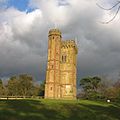Portal:Surrey
| WikiProject Surrey | Surrey Portal |
The Surrey Portal

Surrey (/ˈsʌri/) is a ceremonial county in South East England and one of the home counties. It is bordered by Greater London to the northeast, Kent to the east, East and West Sussex to the south, and Hampshire and Berkshire to the west. The largest settlement is Woking.
The county has an area of 1,663 km2 (642 sq mi) and a population of 1,196,236. Much of the north of the county forms part of the Greater London Built-up Area, which includes the suburbs within the M25 motorway as well as Woking (103,900), Guildford (77,057), and Leatherhead (32,522). The west includes part of the Farnborough/Aldershot built-up area, which extends into Hampshire and Berkshire and has a total population of 252,397. The south of the county is rural, and its largest settlements are Horley (22,693) and Godalming (22,689). The county contains eleven local government districts, which are part of a two-tier non-metropolitan county also called Surrey. The county historically included much of south-west Greater London and excluded Staines-upon-Thames, which was part of Middlesex.
The defining geographical feature of the county is the North Downs, a chalk escarpment which runs from the south-west to north-east and divides the densely populated north from the more rural south; it is pierced by the rivers Wey and Mole, both tributaries of the Thames. The north of the county is a lowland, part of the Thames basin. The south-east is part of the Weald, and the south-west contains the Surrey Hills and Thursley, Hankley and Frensham Commons, an extensive area of heath. The county has the densest woodland cover in England, at 22.4 per cent. (Full article...)
Selected article
The Storming of Farnham Castle occurred on 1 December 1642, during the early stages of the First English Civil War, when a Parliamentarian force attacked the Royalist garrison at Farnham Castle in Surrey. Sir John Denham had taken possession of the castle for the Royalists in mid-November, but after the Royalists had been turned back from London at the Battle of Turnham Green, a Parliamentarian force under the command of Sir William Waller approached the castle. After Denham refused to surrender, Waller's forces successfully stormed the castle. They captured it in under three hours, mostly due to the unwillingness of the Royalist troops to fight. This allowed the Parliamentarians to get close enough to breach the gates, after which the garrison surrendered. (Full article...)
Selected images
Selected biography
Andrew Russell Garfield (born 20 August 1983) is an English and American actor. He has received various accolades, including a Tony Award, a BAFTA TV Award and a Golden Globe, in addition to nominations for a Primetime Emmy Award, a Laurence Olivier Award and two Academy Awards. Time included Garfield on its list of 100 most influential people in the world in 2022.
Born in Los Angeles and raised in Epsom, England, Garfield trained at the Royal Central School of Speech and Drama and began his career on the UK stage and in television productions. He made his feature film debut in the 2007 ensemble drama Lions for Lambs, and gained praise for his performance in the television film Boy A (2007). He came to international attention in 2010 with the supporting role of Eduardo Saverin in the drama The Social Network.
Garfield gained wider recognition for playing Spider-Man in the superhero films The Amazing Spider-Man (2012), The Amazing Spider-Man 2 (2014), and later in Spider-Man: No Way Home (2021). He received nominations for the Academy Award for Best Actor for starring as Desmond Doss in the war film Hacksaw Ridge (2016) and as Jonathan Larson in the musical Tick, Tick... Boom! (2021). Garfield also won a Golden Globe Award for Best Actor for the latter. He has since starred as a Mormon detective in the crime drama miniseries Under the Banner of Heaven (2022).
On stage, Garfield appeared in a 2012 Broadway revival of Death of a Salesman and played Prior Walter in a 2017 London production of Angels in America. He reprised the latter role on Broadway the following year and won the Tony Award for Best Actor in a Play. (Full article...)
Things you can do
 |
Here are some tasks awaiting attention:
|
- –When a task is completed, please remove it from the list.
Did you know
- ... that the first road tunnel in England, opened in 1823 in Reigate, Surrey, runs under the site of a medieval castle?
- ... that the old town hall in Godalming, Surrey, is nicknamed "The Pepperpot" after its distinctive cupola?
- ... that a 10-foot-tall (3 m) chicken stands on a roundabout in Dorking, Surrey?
Subcategories
WikiProjects
Related portals
Topics
|
Associated Wikimedia
The following Wikimedia Foundation sister projects provide more on this subject:
-
Commons
Free media repository -
Wikibooks
Free textbooks and manuals -
Wikidata
Free knowledge base -
Wikinews
Free-content news -
Wikiquote
Collection of quotations -
Wikisource
Free-content library -
Wikiversity
Free learning tools -
Wikivoyage
Free travel guide -
Wiktionary
Dictionary and thesaurus
| WikiProject Surrey Navigation | |
|---|---|
| Main page | Collaboration | Surrey Portal | |


































